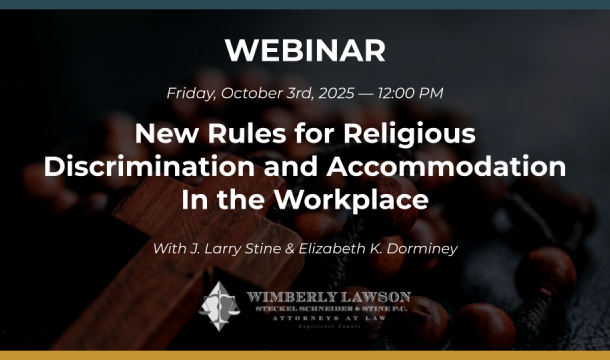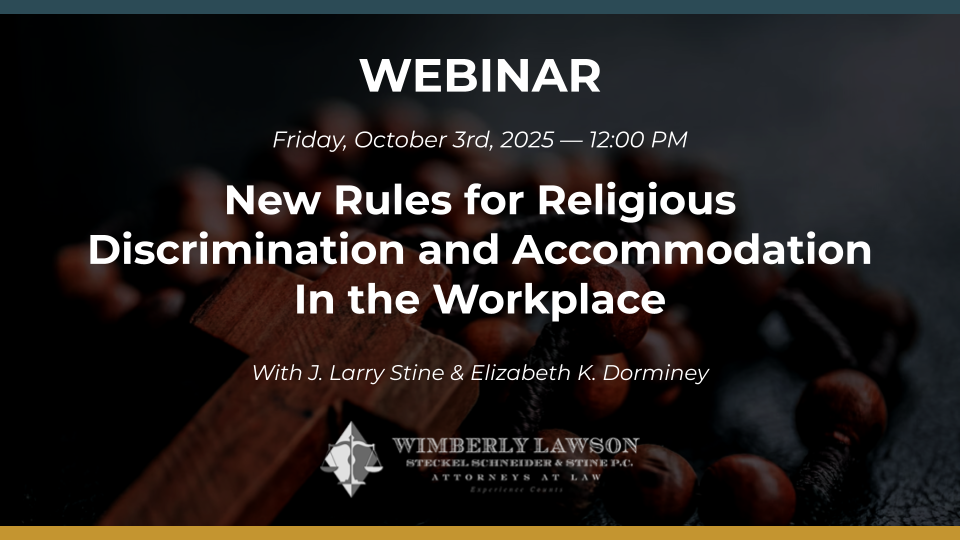With the OSHA Vaccination Mandate Gone, What Happens Next?
Let's first review where we are on the vaccination mandate issue. The U.S. Supreme Court decided in a 6-3 ruling on January 13, 2022 that the Occupational Safety and Health Administration (OSHA) was not empowered by Congress to issue a regulation of such vast significance. At the same time, the high court in a 5-4 ruling indicated that a separate vaccination requirement for about 10 million health-care workers at Medicare- and Medicaid-participating hospitals and other health-care settings could go forward. There is also a separate federal mandate for most federal workers.
Yet to be finally decided by the courts is the separate mandate for federal contractors, which is currently stayed but in which appeals are pending in at least four circuit court of appeals, some of which relate to a nation-wide injunction against the measure from a Georgia federal court. Larry Stine of Wimberly & Lawson led a group of trade associations in obtaining this injunction, currently on appeal, to the Eleventh Circuit. The federal contractor mandate is important even though it cannot currently be enforced while the litigation proceeds, as it would apply to approximately a quarter of the U.S. workforce.
In response to the ruling, President Biden has urged the states and private businesses to nevertheless move ahead in requiring American workers to get Coronavirus shots. The courts have generally ruled that businesses are free to require vaccines for their workers, and the Supreme Court ruling suggests that such mandates are possible at the state level. There is also language in the Supreme Court ruling suggesting that OSHA could promulgate an emergency regulation that would survive judicial review, if such a regulation was "occupation-specific" based on a worker's job at the workplace, such as high-hazard industries. However, promulgating such an industry-specific regulation would be difficult and take a lot of time. In any event, industries previously designated by OSHA as high-risk industries, like meat and poultry processing, manufacturing and warehousing, restaurants, supermarkets and others, will be targeted for enforcement through July 7, 2022 under OSHA's revised National Emphasis Program for COVID-19.
According to a Gallup poll in December, about 36% of workers say their employers are mandating vaccination. Gallup estimates that 25% of U.S. workers remain unvaccinated, and only about 5% of those say they plan to get vaccinated. While many employers already impose vaccination requirements, about 1 in 3 plan to do so only if the OSHA rule took effect. Those employers must now decide what to do in light of the ruling. Some employers, like Boeing and General Electric, have announced they will not implement their vaccination mandate in light of the Supreme Court ruling. A new idea expressed is to apply a "light" approach allowing employees to self-report their COVID test results rather than requiring such oversight.
Many employers face state and local laws that may require vaccine mandates, prohibit vaccine mandates, or require broader religious or medical exemptions. The Supreme Court suggested that states have broader rights to regulate public safety including vaccine mandates. On the other hand, the federal government takes the position that any state or local rules that contradict federal rules on vaccination are pre-empted under the Supremacy Clause of the U.S. Constitution. Issues may also arise in various states, which have their own OSHA laws and standards. At least two of those states have announced they are suspending their vaccination mandates in light of the Supreme Court ruling.
Further, dozens of lawsuits have been filed against vaccine mandates from private employers, although private employers are winning those cases under their management rights to set forth their own safety standards. One area of vulnerability, however, might be lawsuits accusing employers of unlawfully failing to accommodate workers whose religious beliefs or disabilities prevent them from becoming vaccinated. Boeing reported receiving thousands of religious exemption requests. Some commentators have suggested that regular COVID-19 testing could potentially be an accommodation option for such persons. In any event, most employers appear to be liberally granting such exemptions.
It should also be noted that the Supreme Court rulings do not discontinue OSHA's other COVID-19 initiatives, including the issuance of workplace hazard citations under the general duty clause. Further, some employers have been the subject of negligence suits alleging wrongful death or other liabilities to employers for not providing broad and strong protection to employees. Most legal experts believe that while such litigation can be expensive, it is unlikely to succeed on the merits. Workers' compensation pre-emption may preclude most of the claims, although plaintiffs are arguing exceptions to such pre-emption such as deaths or illnesses because a worker allegedly brought COVID-19 home. Plaintiffs would also presumably have to prove that negligence caused the employee's illness and that the virus was not contracted from another source.
In any event, employers have every incentive to comply with health and safety protocols. Employers should consider the implementation of portions of the standard that are practical, although particular state and local laws may limit their efforts. While the federal standard was in effect, it took precedence over state and local restrictions, but without that standard, state and local limits on masks and vaccination mandates could have impact. Many employers will undoubtedly proceed to adopt a written Coronavirus policy, using masking and social distancing as practical.
The Supreme Court ruling is significant in another respect, in that it suggests limits on what has been called the "administrative state." The Court's ruling suggests that courts will be less likely in the future to defer to an agency's interpretation of ambiguous law in regulating a very important issue, or even go further in applying the non-delegation doctrine which forbids Congress from giving agencies the authority to write legislation, a task reserved to Congress.
This is part of our February 2022 Newsletter.
View newsletter online
Download newsletter as a PDF
Related Content
Get Email Updates

Trump Nominates Appointments to NLRB and EEOC but Policy Changes Likely to Be Delayed

DOL Launches Self-Audit Programs Designed to Help Employers Improve Compliance

DOL Must Release EEO-1 Reports to the Public under Open Records Laws

Current Advice on Active-Shooter Situations

New Policy for Federal Workers and Religious Expressions




